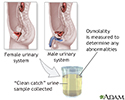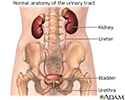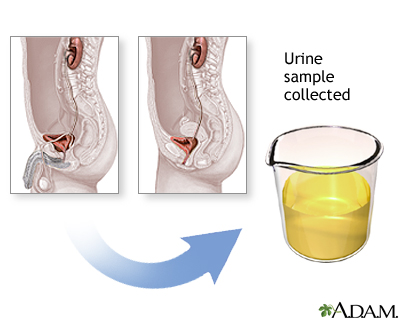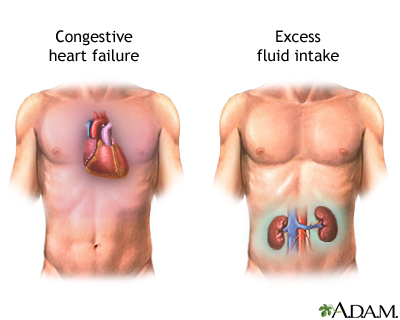Osmolality urine test
The osmolality urine test measures the concentration of particles in urine.
Osmolality can also be measured using a blood test.
How the Test is Performed
A clean-catch urine sample is needed. The clean-catch method is used to prevent germs from the penis or vagina from getting into a urine sample. To collect your urine, the health care provider may give you a special clean-catch kit that contains a cleansing solution and sterile wipes. Follow instructions exactly so that the results are accurate.
Clean-catch urine sample
A clean catch is a method of collecting a urine sample to be tested. The clean-catch urine method is used to prevent germs from the penis or vagina ...
How to Prepare for the Test
Your health care provider may tell you that you need to limit your fluid intake 12 to 14 hours before the test.
Your provider will ask you to temporarily stop taking any medicines that may affect the test results. Be sure to tell your provider about all the medicines you take, including dextran and sucrose. DO NOT stop taking any medicine before talking to your provider.
Also tell your provider if you recently received intravenous dye (contrast medium) for an x-ray. The dye can also affect test results.
How the Test will Feel
The test involves normal urination. There is no discomfort.
Why the Test is Performed
This test helps check your body's water balance and urine concentration.
Osmolality is a more exact measurement of urine concentration than the urine specific gravity test.
Urine specific gravity
Urine specific gravity is a laboratory test that shows the concentration of all chemical particles in the urine.

Normal Results
Normal values are as follows:
- Random specimen: 50 to 1200 mosm/kg
- 12 to 14 hour fluid restriction: Greater than 850 mosm/kg
Normal value ranges may vary slightly among different laboratories. Some labs use different measurements or test different samples. Talk to your provider about the meaning of your specific test results.
What Abnormal Results Mean
Abnormal results are indicated as follows:
Higher than normal measurements may indicate:
-
Heart failure
Heart failure
Heart failure is a condition in which the heart is no longer able to pump oxygen-rich blood to the rest of the body efficiently. This causes symptom...
 ImageRead Article Now Book Mark Article
ImageRead Article Now Book Mark Article - Loss of body fluids (dehydration)
- Narrowing of the kidney artery (renal artery stenosis)
-
Shock
Shock
Shock is a life-threatening condition that occurs when the body is not getting enough blood flow. Lack of blood flow means that the cells and organs...
 ImageRead Article Now Book Mark Article
ImageRead Article Now Book Mark Article - Sugar (glucose) in the urine
-
Syndrome of inappropriate ADH secretion (
SIADH
)
SIADH
Syndrome of inappropriate antidiuretic hormone secretion (SIADH) is a condition in which the body makes too much antidiuretic hormone (ADH). This ho...
Read Article Now Book Mark Article
Lower than normal measurements may indicate:
-
Damage to kidney tubule cells (
renal tubular necrosis
)
Renal tubular necrosis
Acute tubular necrosis is a kidney disorder involving damage to the tubule cells of the kidneys, which can lead to acute kidney failure.
 ImageRead Article Now Book Mark Article
ImageRead Article Now Book Mark Article - Drinking too much fluid
- Kidney failure
- Severe kidney infection (pyelonephritis)
Risks
There are no risks with this test.
References
Inker LA, Fan L, Levey AS. Assessment of renal function. In: Johnson RJ, Feehally J, Floege J. Comprehensive Clinical Nephrology . 5th ed. Philadelphia, PA: Elsevier Saunders; 2015:chap 3.
McPherson RA, Ben-Ezra J. Basic examination of urine. In: McPherson RA, Pincus MR, eds. Henry's Clinical Diagnosis and Management by Laboratory Methods . 22nd ed. Philadelphia, PA: Elsevier Saunders; 2011:chap 28.
-
Osmolality test - illustration
An osmolality urine test is performed to measure the concentration of particles in urine. Greater than normal results may indicate conditions such as Addison's disease, congestive heart failure or shock. Lower-than-normal measurements may indicate aldosteronism, diabetes insipidus, excess fluid intake, renal tubular necrosis or severe pyelonephritis.
Osmolality test
illustration
-
Female urinary tract - illustration
The female and male urinary tracts are relatively the same except for the length of the urethra.
Female urinary tract
illustration
-
Male urinary tract - illustration
The male and female urinary tracts are relatively the same except for the length of the urethra.
Male urinary tract
illustration
-
Osmolality urine - series
Presentation
-
Osmolality test - illustration
An osmolality urine test is performed to measure the concentration of particles in urine. Greater than normal results may indicate conditions such as Addison's disease, congestive heart failure or shock. Lower-than-normal measurements may indicate aldosteronism, diabetes insipidus, excess fluid intake, renal tubular necrosis or severe pyelonephritis.
Osmolality test
illustration
-
Female urinary tract - illustration
The female and male urinary tracts are relatively the same except for the length of the urethra.
Female urinary tract
illustration
-
Male urinary tract - illustration
The male and female urinary tracts are relatively the same except for the length of the urethra.
Male urinary tract
illustration
-
Osmolality urine - series
Presentation
Review Date: 8/29/2015
Reviewed By: Laura J. Martin, MD, MPH, ABIM Board Certified in Internal Medicine and Hospice and Palliative Medicine, Atlanta, GA. Also reviewed by David Zieve, MD, MHA, Isla Ogilvie, PhD, and the A.D.A.M. Editorial team.







